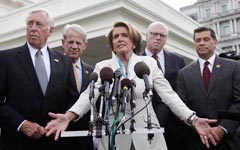Don't hype China's US T-bond trim: economists
(Xinhua) Updated: 2014-02-21 15:25The high yield dragged down bond prices and sapped the value of China's holdings.
|
 |
|
 |
|
 |
China's foreign exchange reserves reached $3.82 trillion by the end of 2013. This means that China put about a third of its reserve stockpile in US T-bonds.
The amount of reserves is expected to further increase as China faces surpluses in both the current account and capital account, said Asian Development Bank economist Zhuang Jian.
As the reserves rise, China's investment into US treasury bonds is not likely to fall in the next few years, Zhuang said.
Guo Tianyong, a professor at China's Central University of Finance and Economics, pointed out that there are risks in having too big a share in US T-bonds.
"Due to the US quantitative easing in recent years, the value of China's dollar assets were in effect diluted, and the yield was not that high with the depreciation of the US dollar," according to Guo.
To better manage the investment of foreign reserves, China should diversify its investment portfolio to wean itself off over-reliance on dollar-based assets, he said.
Meanwhile, the growing forex deposit should be further tapped to benefit domestic economic development by encouraging firms and institutions to hold more foreign exchange, Guo added.
His views were echoed by Tan, who said that the enormous stockpile must be tamed to serve China's real economy, instead of being a burden for investment.
Zhuang suggested that China diversify the use of foreign reserves by further encouraging companies to compete in the global marketplace, expanding channels for corporate and personal uses, and importing resource-related products and technologies.
|
 |
 |
| China's top 10 richest cities |
- NHTSA says finds no 'defect trend' in Tesla Model S sedans
- WTO rare earth ruling is unfair
- Amway says 2014 China sales may grow 8%
- President Xi in Europe: Forging deals, boosting business
- CNOOC releases 2013 sustainability report
- Local production by Chery Jaguar Land Rover this year
- Car lovers test their need for speed in BMW Mission 3
- China stocks close mixed Monday

















